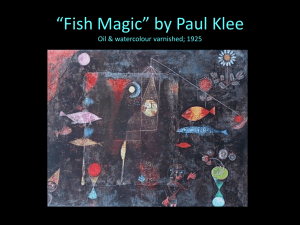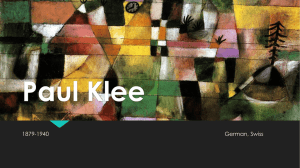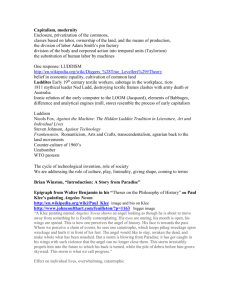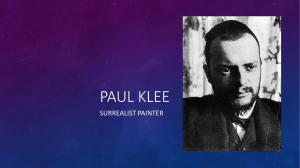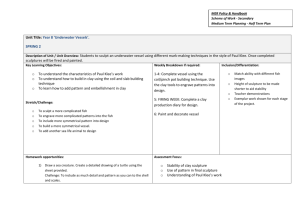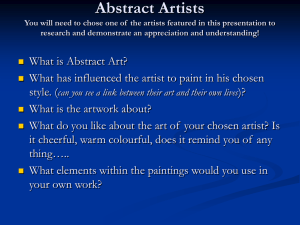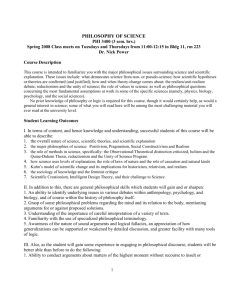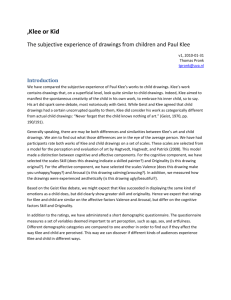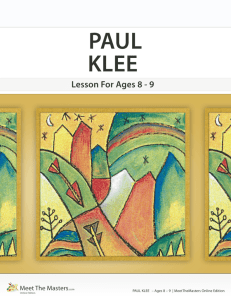Paul Klee
advertisement
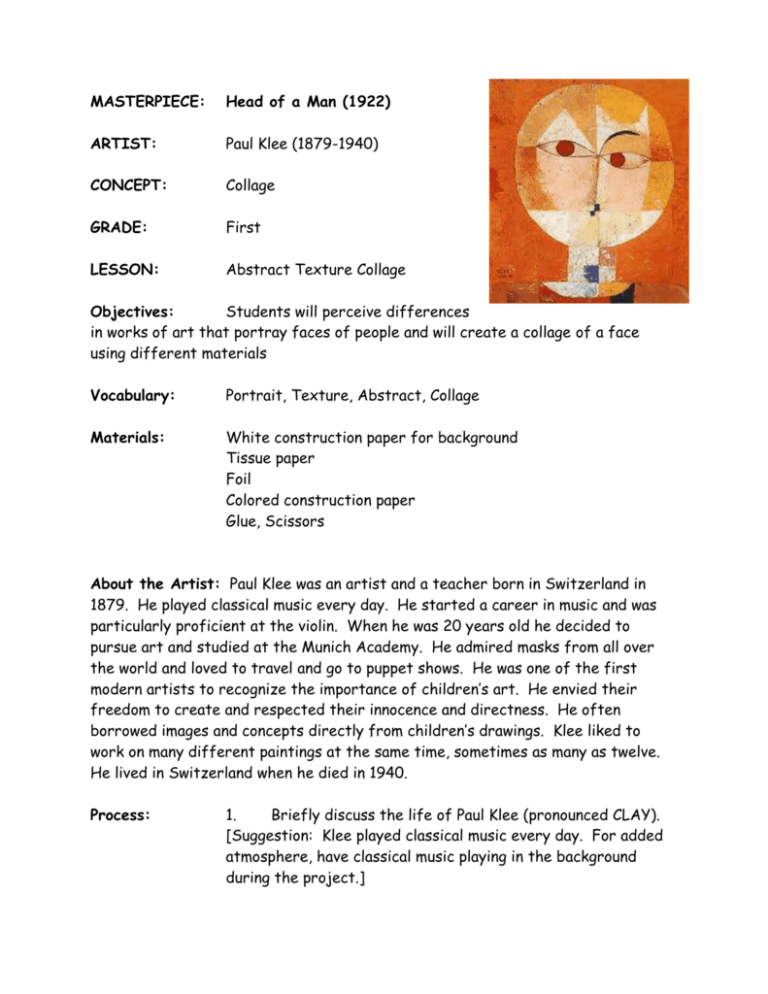
MASTERPIECE: Head of a Man (1922) ARTIST: Paul Klee (1879-1940) CONCEPT: Collage GRADE: First LESSON: Abstract Texture Collage Objectives: Students will perceive differences in works of art that portray faces of people and will create a collage of a face using different materials Vocabulary: Portrait, Texture, Abstract, Collage Materials: White construction paper for background Tissue paper Foil Colored construction paper Glue, Scissors About the Artist: Paul Klee was an artist and a teacher born in Switzerland in 1879. He played classical music every day. He started a career in music and was particularly proficient at the violin. When he was 20 years old he decided to pursue art and studied at the Munich Academy. He admired masks from all over the world and loved to travel and go to puppet shows. He was one of the first modern artists to recognize the importance of children’s art. He envied their freedom to create and respected their innocence and directness. He often borrowed images and concepts directly from children’s drawings. Klee liked to work on many different paintings at the same time, sometimes as many as twelve. He lived in Switzerland when he died in 1940. Process: 1. Briefly discuss the life of Paul Klee (pronounced CLAY). [Suggestion: Klee played classical music every day. For added atmosphere, have classical music playing in the background during the project.] 2. Define portrait and explain life before cameras. 3. Display prints of “Mona Lisa” by Leonardo Da Vinci and/or “American Gothic” by Grant Wood. Ask questions to help with the discussion: Does the painting look like a real person? What tells you it is real? What is she/are they thinking about? Could this be a picture from a camera? [Consider showing a photograph, as well.] 4. Explain that you are going to show them a very different kind of portrait. Define abstract. Display “Head of a Man”. Questions: What do you see in this painting? (a person’s face, neck and shoulders) Does this look like a real person? Do the colors look real? What shapes did the artist use? (circles, squares, triangles) Have you ever seen faces like this on dolls or puppets? 5. Explain that students will be making an abstract collage of a face. Explain that the head does not have to be round, and they must use at least three different shapes and three different colors. Explain how the different materials and colors create texture. They can share scraps with their neighbors. It is OK if theirs looks different from everyone else’s. 6. Distribute materials to students. Make sure their name is on the back. Demonstrate how to trim the corners and edges of a folded paper to create a large face quickly. (The shape can be glued down so the crease from the fold is vertical and used for a center guide for placing the nose, mouth and eyes.) They should plan their portrait on white paper. Glue down the face, then add eyes, nose, ears, etc. Vocabulary Definitions: Portrait: Any form of art that resembles a specific person or animal. Self-Portrait: Any work of Art where the artist portrays himself or herself. Texture: Texture is perceived by touch and sight. Texture refers to the way a surface feels to the sense of touch (actual texture) or how it may appear to the sense of sight (simulated texture). Textures are described by words such as rough, silky, pebbly. Abstract: An abstract artwork is usually based on an identifiable subject, but the artist leaves out details, simplifies or rearranges visual elements. Abstract works that have no identifiable subject are called nonobjective art. Collage: A work of art created by gluing bits of paper, fabric, scraps, photographs or other materials to a flat surface. “Head of a Man” Biographical Information: http://www.paul--klee.com/ Additional Klee Works: http://images.google.com/images?q=paul+klee&hl=en&btnG=Search+Images Paul Klee Münchenbuchsee/Schweiz 1879 - Muralto/Locarno 1940 Paul Klee was born in Münchenbuchsee near Bern on 18 December 1879. In 1898 he decided to move to Munich, where he studied etching and drawing under Heinrich Knirr. Two years later Klee began to study painting at the Munich Art Academy under Franz von Stuck. His first travels took the painter to Rome in 1901/02 and, in 1905, to Paris. Participating in 1908 in the exhibitions mounted by the Munich and Berlin Secessions, Klee met Wassily Kandinsky, Franz Marc and Hans Arp, who would exert the formative influences on his work. Taking part in the second 'Blauer Reiter' exhibition in 1912, Klee met more distinguished contemporaries, such as the artist Alexej von Jawlensky, the poet Rainer Maria Rilke and the writer and composer Herwart Walden. The following year Klee showed work at the First German Herbstsalon. At that time he also did his first watercolours. From 1914 he increasingly devoted himself to working in this medium, most notably during the trip he took to Tunisia with August Macke and Louis René Moilliet. After a two years' stay there, Klee returned to Germany, where he was invited in 1920 by Walter Gropius to teach at the Bauhaus in Weimar. There he worked at first as a Formmeister (Master of Design) and later taught in the free-form painting class. In the years that followed the artist exhibited increasingly both in Germany and abroad: in 1924 he showed work in New York; in 1925 he took part in the first group show of 'painture surréaliste' in Paris, where he shared the honours with Max Ernst, Joan Miró, Pablo Picasso et al. The following year he founded the 'blaue Vier' group together with Kandinsky, Lyonel Feininger and Jawlensky. By then Klee was painting chiefly constructive and absolute pictures. Friendship with Kandinsky and his wife as well as trips to Paris, England and Egypt were a welcome change from teaching at the Bauhaus, an activity which came to restrict the artist's creative powers. An appointment as professor at the Düsseldorfer Academy in 1930 released Klee from his contract with the Bauhaus. Three years later, however, pressure from the National Socialists brought about Klee's dismissal from the Düsseldorf Academy and he moved to Bern. In 1937 the National Socialists removed 102 works by Klee from German museums and that same year 17 of his works were shown at the notorious exhibition of 'Degenerate Art'. This was the period of the Beam-Stroke pictures and the tragic, demonic figurations which indicate Klee's premonitions of death. Not long after the Zurich Kunsthaus devoted a one-man retrospective to him, Paul Klee died at Muralto (Ticino) on 29 June 1940. Art Masterpiece – November – 1st Grade – Paul Klee – Head of a Man Today your first grader had Art Masterpiece and studied the artwork of Paul Klee. Your child created an abstract portrait in Paul Klee style cutting and gluing scraps of paper to create a face. Paul Klee (pronounced Clay) was born in Switzerland in 1879. He studied in Germany and was a proficient violinist. He was one of the first modern artists to recognize the importance of children’s art and often traveled all over the world to see puppet shows. Art Masterpiece – November – 1st Grade – Paul Klee – Head of a Man Today your first grader had Art Masterpiece and studied the artwork of Paul Klee. Your child created an abstract portrait in Paul Klee style cutting and gluing scraps of paper to create a face. Paul Klee (pronounced Clay) was born in Switzerland in 1879. He studied in Germany and was a proficient violinist. He was one of the first modern artists to recognize the importance of children’s art and often traveled all over the world to see puppet shows. Art Masterpiece – November – 1st Grade – Paul Klee – Head of a Man Today your first grader had Art Masterpiece and studied the artwork of Paul Klee. Your child created an abstract portrait in Paul Klee style cutting and gluing scraps of paper to create a face. Paul Klee (pronounced Clay) was born in Switzerland in 1879. He studied in Germany and was a proficient violinist. He was one of the first modern artists to recognize the importance of children’s art and often traveled all over the world to see puppet shows.
